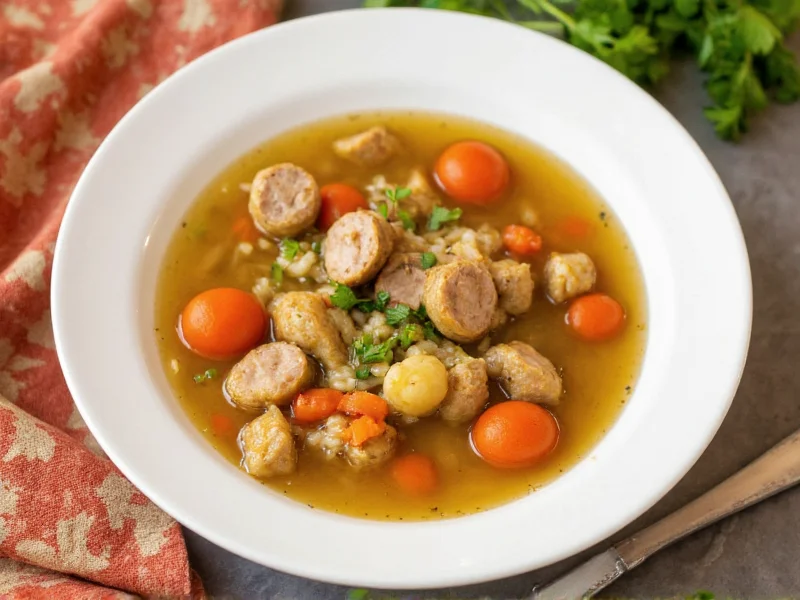When searching for turkey rice soup, home cooks seek more than just ingredients—they want reliable guidance for creating a flavorful, satisfying meal. This comprehensive guide delivers an authentic approach to crafting exceptional turkey rice soup, whether you're using holiday leftovers or starting fresh. The magic lies in balancing broth depth, rice texture, and turkey tenderness while incorporating seasonal vegetables for added nutrition.
The Origins of Turkey Rice Soup
Turkey rice soup emerged as a practical solution for transforming holiday leftovers into comforting meals. While chicken rice soup has ancient roots across Asian and European cuisines, turkey-based versions gained popularity in North America following Thanksgiving celebrations. This adaptation demonstrates culinary resourcefulness, turning what might become food waste into a nourishing dish that provides excellent protein and complex carbohydrates.
Essential Ingredients for Perfect Turkey Rice Soup
The foundation of exceptional easy turkey rice soup recipe lies in ingredient quality and proper ratios. Each component serves a specific purpose in building flavor and texture:
| Ingredient | Function | Recommended Quantity |
|---|---|---|
| Leftover turkey meat | Primary protein source | 2-3 cups, shredded |
| Homemade turkey broth | Flavor foundation | 6 cups |
| Long-grain rice | Texture and heartiness | 1 cup uncooked |
| Aromatic vegetables | Flavor complexity | 1 cup each: onion, carrot, celery |
| Fresh herbs | Aromatic finish | 2 tbsp parsley, 1 tsp thyme |
Step-by-Step Preparation Guide
Creating the perfect healthy turkey and rice soup requires attention to cooking sequence and timing:
- Sauté diced onions, carrots, and celery in olive oil until softened (about 8 minutes)
- Add minced garlic and cook for 1 minute until fragrant
- Pour in turkey broth and bring to gentle simmer
- Add uncooked rice and simmer for 15-18 minutes until tender
- Stir in shredded turkey and fresh herbs
- Season with salt, pepper, and a splash of lemon juice
- Simmer for additional 5 minutes to meld flavors
For a creamy turkey wild rice soup variation, substitute wild rice blend and finish with a splash of heavy cream or coconut milk for dairy-free option.
Popular Variations for Different Preferences
Adapt this versatile turkey vegetable rice soup to suit various dietary needs and flavor preferences:
- Gluten-free version: Ensure broth is certified gluten-free and avoid soy sauce
- Low-sodium option: Use homemade broth and increase herbs for flavor
- Extra vegetable boost: Add spinach, kale, or zucchini during final simmer
- Asian-inspired twist: Incorporate ginger, soy sauce, and bok choy
- Spicy variation: Add red pepper flakes or diced jalapeños
Storage and Reheating Best Practices
Proper storage ensures your leftover turkey rice soup maintains quality:
- Cool completely before storing (within 2 hours of cooking)
- Store in airtight containers for up to 4 days in refrigerator
- Freeze portions for up to 3 months (without dairy additions)
- Reheat gently on stove with small amount of broth or water
- Avoid microwaving large portions to prevent uneven heating
Rice continues absorbing liquid during storage, so you'll likely need to add additional broth when reheating turkey and rice soup leftovers.
Nutritional Benefits of Turkey Rice Soup
This healthy turkey rice soup delivers significant nutritional advantages:
- High-quality protein from turkey supports muscle maintenance
- Complex carbohydrates from rice provide sustained energy
- Vitamins A and K from vegetables boost immune function
- Hydrating broth aids digestion and fluid balance
- Lower calorie density compared to cream-based soups
A standard serving (1.5 cups) typically contains approximately 250-300 calories, 20g protein, and essential vitamins and minerals. For those wondering how to make turkey rice soup more nutrient-dense, adding extra vegetables increases fiber and micronutrient content without significantly increasing calories.
Troubleshooting Common Issues
Address these frequent challenges when preparing turkey vegetable soup with rice:
- Mushy rice: Add rice later in cooking process or use more resilient varieties like basmati
- Bland flavor: Build layers by sautéing vegetables thoroughly and using homemade broth
- Cloudy broth: Skim fat during cooking and avoid boiling vigorously
- Dry turkey: Add turkey near end of cooking and avoid overcooking
- Too thin: Simmer uncovered to reduce or add small amount of cornstarch slurry
Selecting the best rice for turkey soup matters significantly—long-grain varieties like jasmine or basmati maintain better texture than short-grain options during reheating.
Frequently Asked Questions
Can I use cooked rice instead of cooking it in the soup?
Yes, but add cooked rice during the final 5 minutes of cooking to prevent mushiness. Using 2 cups of cooked rice instead of 1 cup uncooked maintains proper soup-to-rice ratio while preserving texture.
How do I prevent the rice from absorbing all the broth?
Store broth and rice separately when meal prepping. When reheating turkey rice soup leftovers, add additional broth or water to restore proper consistency as rice continues absorbing liquid during storage.
What's the best way to use Thanksgiving turkey leftovers for soup?
Remove turkey meat from bones before making soup to ensure even cooking. Simmer the carcass with vegetables to create rich homemade broth, which significantly enhances flavor compared to store-bought alternatives when making leftover turkey rice soup.
Can I make turkey rice soup in a slow cooker?
Absolutely. Sauté vegetables first, then transfer to slow cooker with broth and seasonings. Cook on low for 4-6 hours, adding cooked turkey and rice during the final hour to prevent overcooking. This method develops deeper flavors in your easy turkey rice soup recipe.
Which rice variety works best for turkey soup?
Long-grain white rice maintains the best texture in soup applications. For more nutritional value, brown rice works well but requires longer cooking time. Wild rice blends add visual interest and nutty flavor to creamy turkey wild rice soup variations.











 浙公网安备
33010002000092号
浙公网安备
33010002000092号 浙B2-20120091-4
浙B2-20120091-4